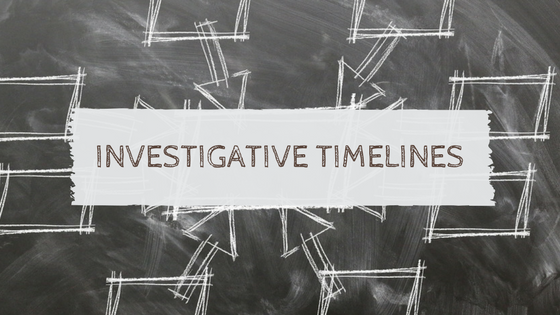
“In the field of observation, chance favors only the prepared minds.”
Louis Pasteur
Investigative case review and analysis are the heart and soul of a criminal defense investigation. Any seasoned private investigator worth his or her salt knows this – and, further, that the case review is where holes in the opposition’s investigation are discovered, alternate theories manifest, missing links are found, and reasonable doubt is born. Proper organization and visual representation of times, places, and events are critical to any investigation.
Where to Begin
Reviewing a complex investigation can be daunting – discovery can range from dozens to tens of thousands of pages. To further complicate matters, discovery can be out of order, incomplete, or in a format that doesn’t lend itself to modern-day document analysis.
Enter the Investigative Timeline
The investigative timeline, in its most basic form, serves as both a reference and a visual tool to identify the relationships between people, places, dates, times and (of course) evidence. All criminal defense investigations should begin and end with an investigative timeline.
Prepration
Investigative timelines come in a variety of formats, ranging from a traditional linear timeline to complex databases. Whatever the format, the timeline should be functional and allow the investigator and defense counsel to clearly and accurately understand how all persons, events, locations, and evidence are interrelated. Commercially available software from SmartDraw, Visio, and RFFlow can assist with the creation of an organized and visually appealing timeline. Utilizing Excel is a great option, too, either as a stand alone timeline platform or in support of another method. Excel is easily searchable and gives the investigator the ability to filter the timeline by key categories.
As discovery is reviewed, information is collected and the defense investigation progresses, all key information relating to dates, times, locations, persons, events, and evidence should be entered into the timeline. It’s important to note the source of each piece of information entered. The timeline will remain a living document throughout the investigation, allowing the defense to develop a clearer picture of the facts and create a road map for the investigation.
How to Utilize the Timeline
The well-developed timeline provides clarity to a complex case, and it should be used as a reference to understand important relationships. By studying a timeline, both the investigator and defense counsel can determine where gaps in the investigation exist, document the movement of witnesses and victims, exploit inconsistencies, develop alibis, and evaluate the plausibility of the opposing counsel’s case. An organized and visually appealing timeline makes an excellent defense exhibit, assisting defense counsel when cross-examining witnesses and presenting reasonable doubt to jurors.
Conclusion
The investigative timeline is an often-overlooked tool, but since it can assist with both understanding and introducing reasonable doubt in the prosecution’s case, it is critical to implement whenever possible. Documenting inconsistencies in witness statements and events will elevate defense counsel’s position during negotiations, help lower bond for the defendant, reduce charges, or even result in a dismissal of the case.
About the Author
Private Investigator Steven Mason, Mason Investigative Solutions, is a former federal criminal investigator and certified Federal Law Enforcement Training Center Adjunct Instructor. Mr. Mason’s curriculum vitae has been accepted by the United States District Court for the District of Arizona, approving him to conduct federal criminal defense investigations.
[…] A version of this article first appeared on the Mason Investigative Solutions blog. […]